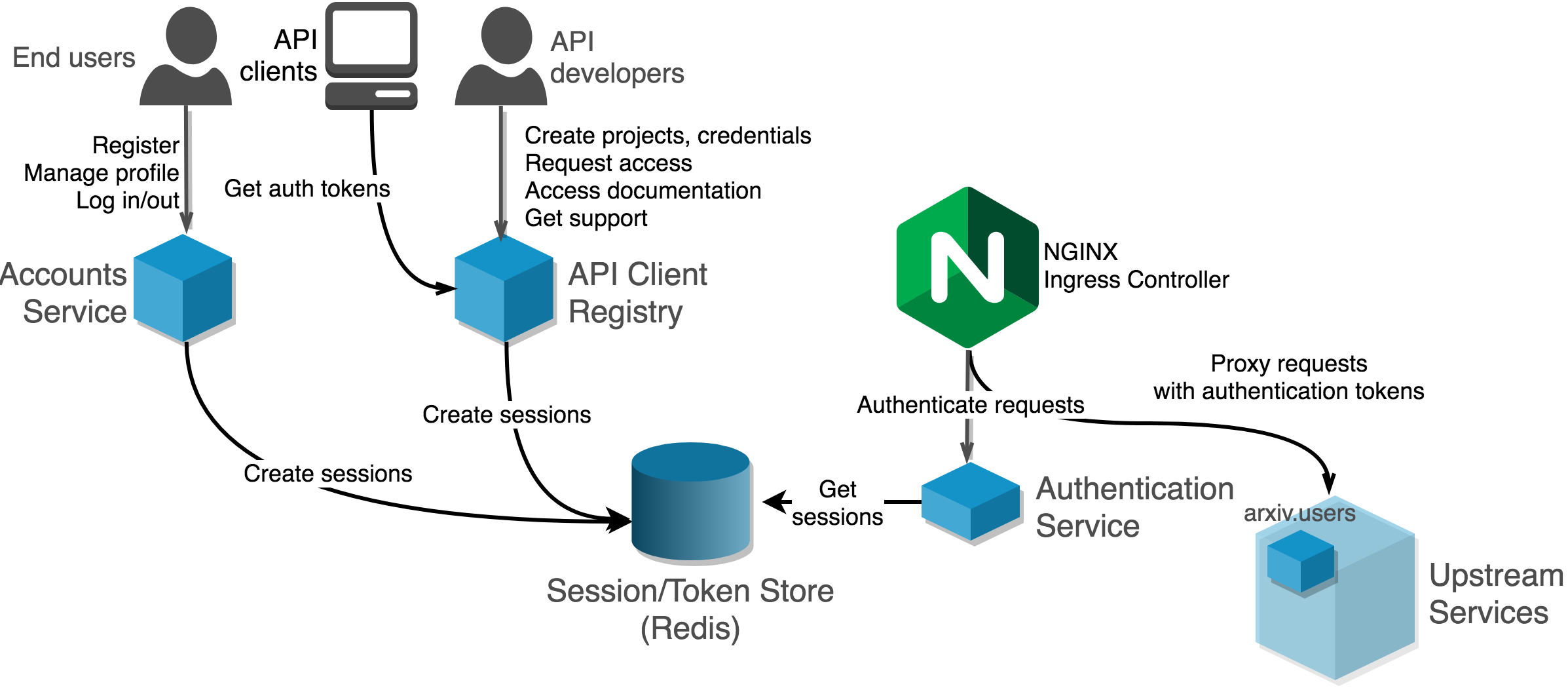arXiv Authorization & Authentication¶
The accounts and authorization subsystem is responsible for providing user accounts and profiles as well as mechanisms for authentication and authorization. This subsystem also provides the API client portal, which supports generation of application tokens, OAuth2 workflows, and a public API client application portal that end-users can use to discover tools and services built on top of arXiv APIs.
The arXiv platform provides both anonymous and authenticated interfaces to end-users (including moderators), API clients, and the arXiv operations team. This project provides applications and libraries to support authentication and authorization, including account creation and login, user sessions, and API token management. TLS is considered an infrastructure concern, and is therefore out of scope (albeit critical) for this project.
Objectives & Requirements¶
- Users must be able to register for and log in to the arXiv site, and interact with parts of the platform that require authentication, and do so securely.
- Once logged in, a user should be able to access services/endpoints for which they are authorized regardless of where that service is deployed.
- API clients must be able to authenticate with the arXiv site, and obtain secure authorization tokens using OAuth2 protocols.
- Administrators must be able to grant and revoke authorization for specific actions and services within the arXiv platform, using a role-based system.
- It must be possible to revoke access from a user or client, and have that revocation take effect immediately.
- Accessing authentication and authorization information in an arXiv service/application must not require implementing new integrations; we need a single, consistent solution for authn/z concerns in Flask applications.
- Services/applications deployed in the cloud must be able to obtain authn/z information without accessing a central database. Services/applications deployed on-premises must integrate with the legacy database so that users can seamlessly move between legacy and NG interfaces using the same session.
Services¶
The objectives above are separated into four distinct concerns, each addressed by a separate piece of software.
arxiv.usersPackage- A Python library that provides middleware and other components for working with user/client sessions and authorization in arXiv services.
Accounts Service- Provides user registration and login mechanisms, access control management, and user profiles.
Authentication Service- Handles authentication subrequests from ingress controllers. Validates user session keys and API access keys, and generates internal authorization tokens.
API Client Registry- Provides API client/application registration, generation of client keys, and a public-facing searchable directory of client projects and services. Also provides API documentation.
The accounts and authenticator services are underlain by a distributed keystore (HA Redis cluster) for registration and validation of session and access keys.
Cross-Cutting Concerns¶
Role-Based Access Control¶
Access control addresses what users are authorized to access and what users are authorized to do in the system. The classic arXiv system uses an access control mechanism similar to the Discretionary Access Control model, in which an Access Control List specifies what individual users can do in specific areas of the system and in relation to specific resources. DAC/ACL systems are often sufficient for systems with a relatively small number of users, but become difficult to manage as the user base grows or the system becomes more complex.
The NG architecture adopts Role-Based Access Control, in which authorizations accrue instead to abstract “roles” to which multiple users belong. For example, several users might belong to a “moderator” role, to which specific authorizations (e.g. “can propose subject classifications”, “can view the moderator interface”) are attached. The main advantage of RBAC is ease of administration: policies can be added to and removed from roles without consideration of the specific users impacted; users can be granted a specific set of authorizations by simply adding them to a role, rather than attaching an array of individual policies directly to the user.
